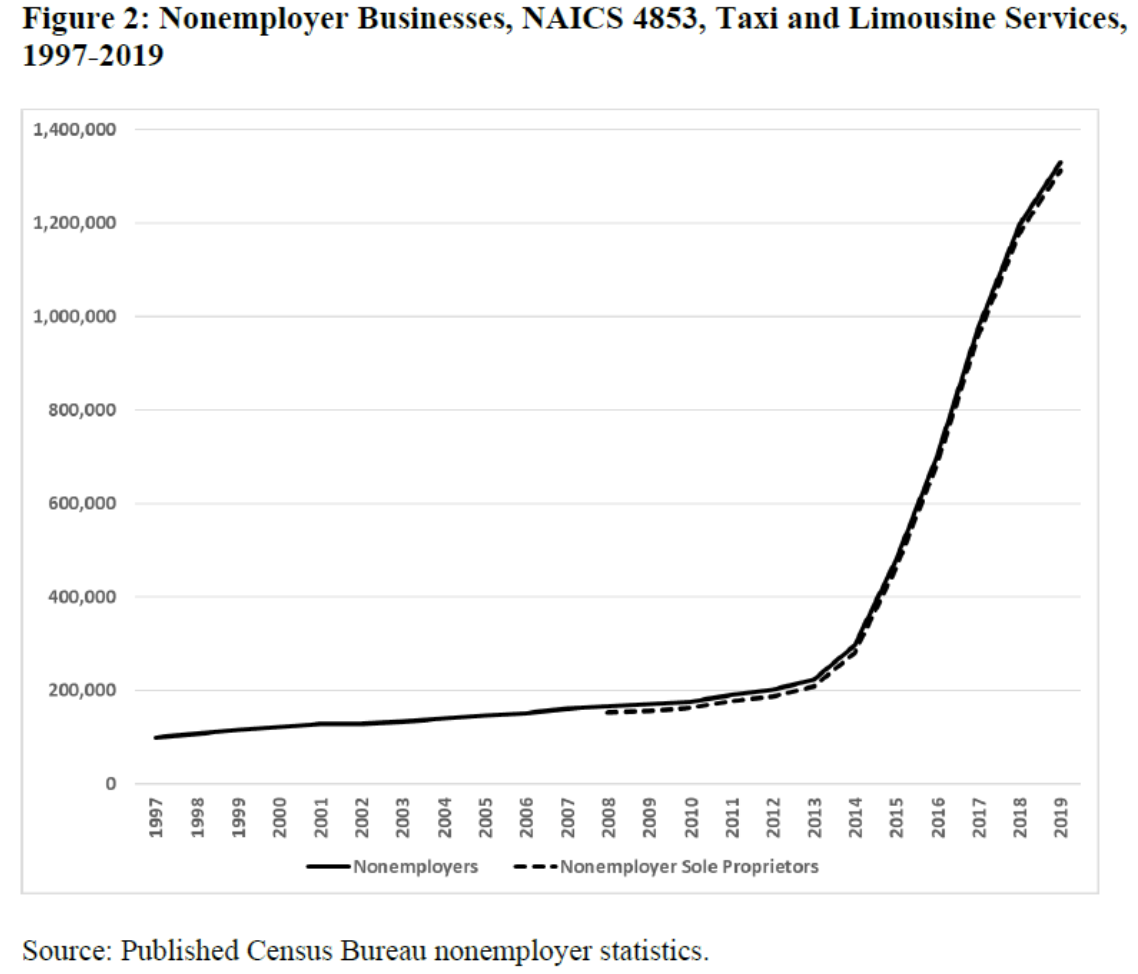Comments
- No comments found

The idea for Uber reportedly came on a snowy evening in Paris around 2008 when Travis Kalanick and Garrett Camp struggled to find a taxi.
They wondered “What if you could request a ride simply by tapping your phone?” They co-founded Uber based on an idea that has seemed so obvious for years now, but it would have seemed a practical impossibility just 20 years ago, before the invention of the iPhone and the broader spread of smartphone technology.
Katharine G. Abraham, John C. Haltiwanger, Claire Y. Hou, Kristin Sandusky, and James Spletzer disinter some government statistics on the evolution of the ride-share market over time in “Driving the Gig Economy” (NBER Working Paper 32766, August 2024).
There’s something called the North American Industry Classification System (NAICS), which among other uses can provide employment totals by industry. The authors look at self-employment in the Taxi and Limousine Services industry, which is coded as NAICS 4853. Here’s the employment trend:

The authors focus on the factors and effects of this labor market entry, and in comparing patterns across cities. From the abstract:
New entrants were more likely to be young, female, White and U.S. born, and to combine earnings from ridesharing with wage and salary earnings. Displaced workers have found ridesharing to be a substantially more attractive fallback option than driving a taxi. Ridesharing also affected the incumbent taxi driver workforce. The exit rates of low-earning taxi drivers increased following the introduction of ridesharing in their city; exit rates of high-earning taxi drivers were little affected. In cities without regulations limiting the size of the taxi fleet, both groups of drivers experienced earnings losses following the introduction of ridesharing. These losses were ameliorated or absent in more heavily regulated markets.
Here, I want to focus instead on a different angle. Back around 2009, there apparently was an untapped reservoir of more than a million people who were willing to drive others for money. But many of these potential drivers put a high value on the flexibility of organizing their own time. There were millions of potential riders willing to hire those drivers. However, both sides needed reassurance. For the rider, would the fare and the route be locked in before the driver arrived? How long until the driver arrived and how long would the trip take? For the driver, was payment for the ride guaranteed via credit card before the ride started? Could the route and destination be known in advance? Was it safe for a driver to pick someone up–or at least safer to pick up someone with a ride-share account than someone waving at you from a street corner?
Now we tend to take the ride-sharing services for granted. For me, the ride-sharing companies offer an occasional but substantial gain in convenience; for the elderly, the disabled, the intoxicated, those who can’t afford a car, those who need to get to a medical appointment where it’s better not to drive, and others, ride-sharing can be a lifeline. I have family members who rely on ride-sharing completely. In my local area, when the Minneapolis City Council threatened to regulate the ride-sharing services out of Minnesota, it was potentially a disaster for both existing users and drivers
So here’s my question: If someone in the private sector like Kalanick and Camp had not started a ride-sharing company, would it have happened? After all, there was no technological barrier that prevented existing taxicab companies from offering a similar phone app. But in many cities, entry into taxicab markets back in the early 2000s was restricted, usually based on claims about safety and quality of service, but in practice also helping to hold down supply and increase incomes of existing cab drivers.
There seems to me a vanishingly small chance that the existing taxicab companies in the early 21st century would have disrupted their existing business model by expanding the number of drivers more than 10-fold, or offering the advance guarantee of routes and fares that is common to ride-sharing. The chances are even smaller (if “even smaller” is possible), that some government transit agency would have pioneered this decentralized approach.
Many of us now take the widespread availability of ride-sharing for granted. Indeed, many people take the restless innovation and energy of markets for granted in general. Ride-sharing in the real world has its warts and flaws and tradeoffs, as did the previous regime of taxicabs had, as do all real world institutions. But ride-sharing seems to me like an overall dramatic gain in welfare for the million-plus drivers who participate and the many millions of riders. And without the disruptive pressure of market forces, it would not have happened for years, or decades, or perhaps at all.
Timothy Taylor is an American economist. He is managing editor of the Journal of Economic Perspectives, a quarterly academic journal produced at Macalester College and published by the American Economic Association. Taylor received his Bachelor of Arts degree from Haverford College and a master's degree in economics from Stanford University. At Stanford, he was winner of the award for excellent teaching in a large class (more than 30 students) given by the Associated Students of Stanford University. At Minnesota, he was named a Distinguished Lecturer by the Department of Economics and voted Teacher of the Year by the master's degree students at the Hubert H. Humphrey Institute of Public Affairs. Taylor has been a guest speaker for groups of teachers of high school economics, visiting diplomats from eastern Europe, talk-radio shows, and community groups. From 1989 to 1997, Professor Taylor wrote an economics opinion column for the San Jose Mercury-News. He has published multiple lectures on economics through The Teaching Company. With Rudolph Penner and Isabel Sawhill, he is co-author of Updating America's Social Contract (2000), whose first chapter provided an early radical centrist perspective, "An Agenda for the Radical Middle". Taylor is also the author of The Instant Economist: Everything You Need to Know About How the Economy Works, published by the Penguin Group in 2012. The fourth edition of Taylor's Principles of Economics textbook was published by Textbook Media in 2017.
Leave your comments
Post comment as a guest